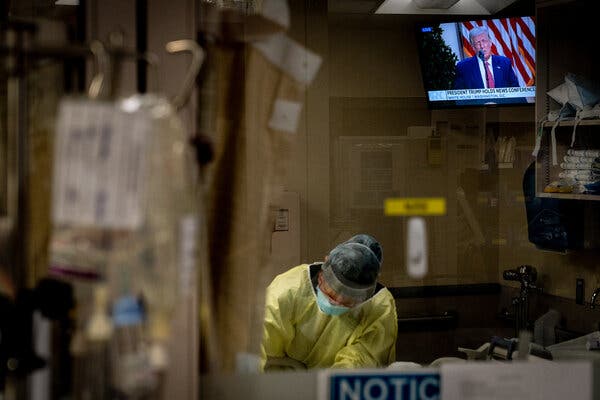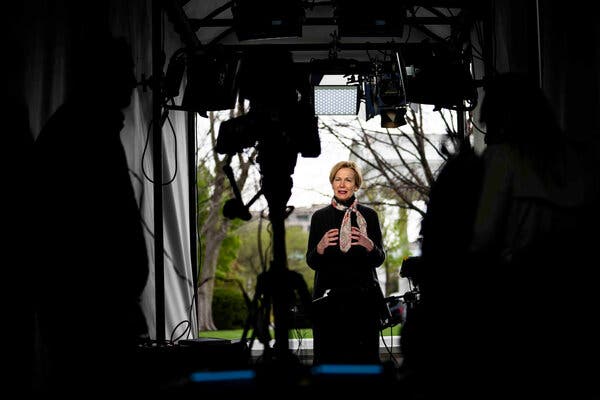Advertisement
The roots of the nation’s current inability to control the pandemic can be traced to mid-April, when the White House embraced overly rosy projections to proclaim victory and move on.

WASHINGTON — Each morning at 8 as the coronavirus crisis was raging in April, Mark Meadows, the White House chief of staff, convened a small group of aides to steer the administration through what had become a public health, economic and political disaster.
Seated around Mr. Meadows’s conference table and on a couch in his office down the hall from the Oval Office, they saw their immediate role as practical problem solvers. Produce more ventilators. Find more personal protective equipment. Provide more testing.
But their ultimate goal was to shift responsibility for leading the fight against the pandemic from the White House to the states. They referred to this as “state authority handoff,” and it was at the heart of what would become at once a catastrophic policy blunder and an attempt to escape blame for a crisis that had engulfed the country — perhaps one of the greatest failures of presidential leadership in generations.
Over a critical period beginning in mid-April, President Trump and his team convinced themselves that the outbreak was fading, that they had given state governments all the resources they needed to contain its remaining “embers” and that it was time to ease up on the lockdown.
In doing so, he was ignoring warnings that the numbers would continue to drop only if social distancing was kept in place, rushing instead to restart the economy and tend to his battered re-election hopes.
Casting the decision in ideological terms, Mr. Meadows would tell people: “Only in Washington, D.C., do they think that they have the answer for all of America.”
For scientific affirmation, they turned to Dr. Deborah L. Birx, the sole public health professional in the Meadows group. A highly regarded infectious diseases expert, she was a constant source of upbeat news for the president and his aides, walking the halls with charts emphasizing that outbreaks were gradually easing. The country, she insisted, was likely to resemble Italy, where virus cases declined steadily from frightening heights.
On April 11, she told the coronavirus task force in the Situation Room that the nation was in good shape. Boston and Chicago are two weeks away from the peak, she cautioned, but the numbers in Detroit and other hard-hit cities are heading down.
A sharp pivot soon followed, with consequences that continue to plague the country today as the virus surges anew.
Even as a chorus of state officials and health experts warned that the pandemic was far from under control, Mr. Trump went, in a matter of days, from proclaiming that he alone had the authority to decide when the economy would reopen to pushing that responsibility onto the states. The government issued detailed reopening guidelines, but almost immediately, Mr. Trump began criticizing Democratic governors who did not “liberate” their states.
Mr. Trump’s bet that the crisis would fade away proved wrong. But an examination of the shift in April and its aftermath shows that the approach he embraced was not just a misjudgment. Instead, it was a deliberate strategy that he would stick doggedly to as evidence mounted that, in the absence of strong leadership from the White House, the virus would continue to infect and kill large numbers of Americans.

He and his top aides would openly disdain the scientific research into the disease and the advice of experts on how to contain it, seek to muzzle more authoritative voices like Dr. Anthony S. Fauci and continue to distort reality even as it became clear that his hopes for a rapid rebound in the economy and his electoral prospects were not materializing.
Mr. Trump had missed or dismissed mounting signals of the impending crisis in the early months of the year. Now, interviews with more than two dozen officials inside the administration and in the states, and a review of emails and documents, reveal previously unreported details about how the White House put the nation on its current course during a fateful period this spring.
-
Key elements of the administration’s strategy were formulated out of sight in Mr. Meadows’s daily meetings, by aides who for the most part had no experience with public health emergencies and were taking their cues from the president. Officials in the West Wing saw the better-known White House coronavirus task force as dysfunctional, came to view Dr. Fauci as a purveyor of dire warnings but no solutions and blamed officials from the Centers for Disease Control and Prevention for mishandling the early stages of the virus.
-
Dr. Birx was more central than publicly known to the judgment inside the West Wing that the virus was on a downward path. Colleagues described her as dedicated to public health and working herself to exhaustion to get the data right, but her model-based assessment nonetheless failed to account for a vital variable: how Mr. Trump’s rush to urge a return to normal would help undercut the social distancing and other measures that were holding down the numbers.
-
The president quickly came to feel trapped by his own reopening guidelines. States needed declining cases to reopen, or at least a declining rate of positive tests. But more testing meant overall cases were destined to go up, undercutting the president’s push to crank up the economy. The result was to intensify Mr. Trump’s remarkable public campaign against testing, a vivid example of how he often waged war with science and his own administration’s experts and stated policies.
-
Mr. Trump’s bizarre public statements, his refusal to wear a mask and his pressure on states to get their economies going again left governors and other state officials scrambling to deal with a leadership vacuum. At one stage, Gov. Gavin Newsom of California was told that if he wanted the federal government to help obtain the swabs needed to test for the virus, he would have to ask Mr. Trump himself — and thank him.
-
Not until early June did White House officials even begin to recognize that their assumptions about the course of the pandemic had proved wrong. Even now there are internal divisions over how far to go in having officials publicly acknowledge the reality of the situation.
Judd Deere, a White House spokesman, said the president had imposed travel restrictions on China early in the pandemic, signed economic relief measures that have provided Americans with critical assistance and dealt with other issues including supplies of personal protective equipment, testing capacity and vaccine development.
“President Trump and his bold actions from the very beginning of this pandemic stand in stark contrast to the do-nothing Democrats and radical left who just complain, criticize and condemn anything this president does to preserve this nation,” he said.
At a briefing on April 10, Mr. Trump predicted that the number of deaths in the United States from the pandemic would be “substantially” fewer than 100,000. As of Saturday, the death toll stood at 139,186, the pace of new deaths was rising again and the country, logging a seven-day average of 65,790 new cases a day, had more confirmed cases per capita than any other major industrial nation.
The president had a decision to make.
It was the end of March and his initial, 15-day effort to slow the spread of the virus by essentially shutting down the country was expiring in days. Sitting in front of the Resolute Desk in the Oval Office were Drs. Fauci and Birx, along with other top officials. Days earlier, Mr. Trump had said he envisioned the country being “opened up and raring to go” by Easter, but now he was on the verge of announcing that he would keep the country shut down for another 30 days.
“Do you really think we need to do this?” the president asked Dr. Fauci. “Yeah, we really do need to do it,” Dr. Fauci replied, explaining again the federal government’s role in making sure the virus did not explode across the country.
Mr. Trump’s willingness to go along — driven in part by grim television images of bodies piling up at Elmhurst Hospital Center in New York City — was a concession that federal responsibility was crucial to defeating a virus that did not respect state boundaries. In a later Rose Garden appearance, he appeared resigned to continuing the battle.
“Nothing would be worse than declaring victory before the victory is won,” Mr. Trump said.
But even as the president was acknowledging the need for tough decisions, he and his aides would soon be looking to do the opposite — build a public case that the federal government had completed its job and unshackle the president from ownership of the response.


